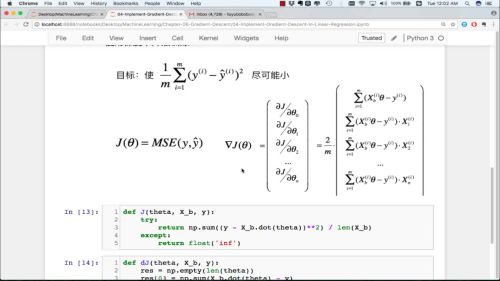课程介绍
课程名称:Python3入门机器学习 经典算法与应用 入行人工智能
课程章节:6-1;6-2;6-3;6-4
主讲老师:liuyubobobo
内容导读
- 第一部分 梯度下降与学习率
- 第二部分 封装函数并研究学习率
- 第三部分 线性回归中的梯度下降法
- 第四部分 代码展示
课程详细
- 第一部分 梯度下降与学习率
本身不是一个机器学习算法,不能解决分类或者回归问题
是一种基于搜索的最优化方法
作用:最小化一个损失函数
梯度上升法:最大化一个效用函数
#自己搞出一条线条X,Y来进行模拟梯度下降中的J与theta
import numpy as np
import matplotlib.pyplot as plt
plot_x = np.linspace(-1, 6, 141)
plot_y = (plot_x - 2.5)**2 -1
plt.plot(plot_x, plot_y)
plt.show()

#对j进行求导
def dJ(theta):
return 2*(theta-2.5)
#确定损失函数是多少
def J(theta):
return (theta - 2.5)**2 -1
#学习率
eta = 0.1
#初始化参数
theta = 0.0
#退出循环的条件:上一个J值与下一个J值差值,小于epsilon
epsilon = 1e-8
#保存theta变化的情况,用于后续绘图
history_theta = [theta]
while True:
#把每次求出的倒数,放到gradient中
gradient = dJ(theta)
#保存上一个theta的值
last_theta = theta
#对theta进行求导找出方向,然后梯度下降
theta = theta - eta * gradient
##保存theta历史数据
history_theta.append(theta)
#退出循环条件一
if (abs(J(theta) - J(last_theta)) < epsilon):
break
plt.plot(plot_x, J(plot_x))
plt.scatter(history_theta,J(np.array(history_theta)), color='r', marker="+")
plt.show()

- 第二部分 封装函数并研究学习率
def gradient_descent(initial_theta, eta, epsilon=1e-8):
theta = initial_theta
theta_history.append(initial_theta)
while True:
#把每次求出的倒数,放到gradient中
gradient = dJ(theta)
#保存上一个theta的值
last_theta = theta
#对theta进行求导找出方向,然后梯度下降
theta = theta - eta * gradient
##保存theta历史数据
theta_history.append(theta)
#退出循环条件一
if (abs(J(theta) - J(last_theta)) < epsilon):
break
def plot_theta_history():
plt.plot(plot_x, J(plot_x))
plt.plot(np.array(theta_history), J(np.array(theta_history)), color="r", marker="+" )
plt.show()
学习率较小的情况
eta = 0.01
theta_history = []
gradient_descent(0., eta)
plot_theta_history()
len(theta_history)
#运行了423次,由图也可以看出,循环了很多次

学习率稍小的情况
eta = 0.3
theta_history = []
gradient_descent(0., eta)
plot_theta_history()
len(theta_history)
#运行了13次,由图也可以看出,找对学习率是能提升运算效率,不过最重要的是找到极值,而非找到最好的学习率

学习率稍大的情况
eta = 0.8
theta_history = []
gradient_descent(0., eta)
plot_theta_history()
len(theta_history)
#运行了22次,由图也可以看出,曲线一下左一下右,但是似乎也是在下降的过程,最终运行22次达到了极值点附近

学习率太大的情况
eta = 1.1
theta_history = []
gradient_descent(0., eta)
plot_theta_history()
#报错了,应为J发散了,越来越大
#这时候调整,J函数要是报错就返回inf也就是i无穷大
#和给梯度下降函数增加一个num退出循环条件
#OverflowError: (34, 'Result too large')
#修改后出错就返回正无穷
def J(theta):
try:
return (theta-2.5) ** 2 - 1
except:
return float('inf')
def gradient_descent(initial_theta, eta, n_iters = 1e4, epsilon=1e-8):
theta = initial_theta
i_iter = 0
theta_history.append(initial_theta)
while i_iter < n_iters:
gradient = dJ(theta)
last_theta = theta
theta = theta - eta * gradient
theta_history.append(theta)
if(abs(J(theta) - J(last_theta)) < epsilon):
break
i_iter += 1
return
eta = 1.1
theta_history = []
gradient_descent(0, eta)
#修改后是可以运行的,
eta = 1.1
theta_history = []
gradient_descent(0, eta, n_iters=5)
plot_theta_history()
#它发散了

从这几幅图可以清晰地看出来,学习率选择的重要性,当你发现你的J损失函数,无穷大的时候,那就要检查一下是不是发散了,同时可以试着减小学习率
- 第三部分 线性回归中的梯度下降法
#导入代码
import numpy as np
import matplotlib.pyplot as plt
#创建数据
np.random.seed(666)
x = 2 * np.random.random(size=100)
y = x * 3. + 4.+ np.random.normal(size=100)
#更改格式
X = x.reshape(-1,1)
X.shape
plt.scatter(x, y)
plt.show()

#计算J的值
def J(theta, X_b, y):
try:
return np.sum((y - X_b.dot(theta) ) ** 2) / len(X_b)
except:
return float('inf')
#计算J的导数
def dJ(theta, X_b, y):
res = np.empty(len(theta))
res[0] = np.sum(X_b.dot(theta) - y)
for i in range(1, len(theta)):
print(i,X_b[:,i])
res[i] = np.sum((X_b.dot(theta) - y).dot(X_b[:,i]))
return res * 2 / len(X_b)
#改进版-向量化
def dJ(theta, X_b, y):
reg = np.array(X_b.dot(theta) - y).dot(X_b)
return reg * 2 / len(X_b)
def gradient_descent(X_b, y ,initial_theta, eta, n_iters = 1e4, epsilon=1e-8):
#初始化,theta的值,运行次数的值,theta历史的数字
theta = initial_theta
i_iter = 0
theta_history = []
theta_history.append(initial_theta)
#运行次数超过1万次就退出循环条件1
while i_iter < n_iters:
#求导数
gradient = dJ(theta, X_b, y)
#赋值历史theta,用于判断退出循环条件2
last_theta = theta
#梯度下降,
theta = theta - eta * gradient
#写入历史记录
theta_history.append(theta)
#推出条件,J与上一个J的值差距小于1e-8
if(abs(J(theta, X_b, y) - J(last_theta, X_b, y)) < epsilon):
break
#用于记录运行次数
i_iter += 1
return theta
#合并,在X前插入全1向量
X_b = np.concatenate([np.ones((len(X),1)),X ],axis=1)
#随机化系数
theta = np.array(np.random.randint(1,100,X_b.shape[1]))
eta = 0.01
theta = gradient_descent(X_b, y, theta, eta)
#array([4.02145777, 3.00706285])
#准确无误
#成功训练出模型
进行封装代码,并调用
from nike.LinearRegression import LinearRegression
lin_reg = LinearRegression()
lin_reg.fit_gd(X, y)
lin_reg.coef_
#array([3.00328737])
lin_reg.intercept_
#4.025934058956716
- 第四部分 代码展示
import numpy as np
from .metrics import r2_score
class LinearRegression:
def __init__(self):
"""初始化多元线性回归模型"""
#初始化截距coef_和系数interception_,和theta私有化参数
self.coef_ = None
self.intercept_ = None
self._theta = None
def fit_normal(self, X_train ,y_train):
assert X_train.shape[0] ==y_train.shape[0],\
"the size of X_train must be equal to the size of y_train"
#ones(多少个,0or1行和列)
X_b = np.concatenate(([np.ones((len(X_train), 1)), X_train]), axis=1)
self._theta = np.linalg.pinv(X_b.T.dot(X_b)).dot(X_b.T).dot(y_train)
self.intercept_ = self._theta[0]
self.coef_ = self._theta[1:]
return self
def fit_gd(self,X_train, y_train, eta=0.01, n_iters=1e4, epsilon=1e-8):
assert X_train.shape[0] == y_train.shape[0], \
"the size of X_train must be equal to the size of y_train"
# 计算J的值
def J(theta, X_b, y):
try:
return np.sum((y - X_b.dot(theta)) ** 2) / len(X_b)
except:
return float('inf')
# 计算J的导数
def dJ(theta, X_b, y):
reg = np.array(X_b.dot(theta) - y).dot(X_b)
return reg * 2 / len(X_b)
def gradient_descent(X_b, y, initial_theta, eta, n_iters=1e4, epsilon=1e-8):
# 初始化,theta的值,运行次数的值,theta历史的数字
theta = initial_theta
i_iter = 0
theta_history = []
theta_history.append(initial_theta)
# 运行次数超过1万次就退出循环条件1
while i_iter < n_iters:
# 求导数
gradient = dJ(theta, X_b, y)
# 赋值历史theta,用于判断退出循环条件2
last_theta = theta
# 梯度下降,
theta = theta - eta * gradient
# 写入历史记录
theta_history.append(theta)
# 推出条件,J与上一个J的值差距小于1e-8
if (abs(J(theta, X_b, y) - J(last_theta, X_b, y)) < epsilon):
break
# 用于记录运行次数
i_iter += 1
return theta
# 合并,在X前插入全1向量
X_b = np.concatenate([np.ones((len(X_train), 1)), X_train], axis=1)
# 随机化系数
initial_theta = np.array(np.random.randint(1, 100, X_b.shape[1]))
self._theta = gradient_descent(X_b, y_train, initial_theta, eta)
self.intercept_ = self._theta[0]
self.coef_ = self._theta[1:]
return self
def predict(self,X_predict):
assert self.intercept_ is not None and self.coef_ is not None,\
'must fit before predict'
assert X_predict.shape[1] == len(self.coef_),\
'the feature number of X_predict must be equal to X_train'
X_b = np.concatenate([np.ones((len(X_predict),1)),X_predict], axis=1)
return X_b.dot(self._theta)
def score(self, X_test, y_test):
y_predict = self.predict(X_test)
return r2_score(y_test, y_predict)
def __repr__(self):
return "LinearRegression()"
# if __name__ == '__main__':
# X_b = np.concatenate([np.ones((10, 1)), np.ones((10, 1))], axis=1)
# print(X_b)
课程思考
梯度下降的算法,有些求导的地方还是有点迷糊,还有numpy包的智能识别乘法,让我在调整好格式带入,老是出错,迷糊了半天,后来发现在数学上有些不能相乘的,他能自动识别进行转换格式,但是自己转换输入就会出错,要是没有老师代码对照着看,还真的很难发现。另外有时候一个括号之差就会导致程序出错,特别是在函数公式处,一定要详细检查格式,优先级等等。
课程截图


 随时随地看视频
随时随地看视频




